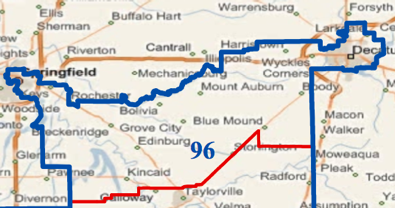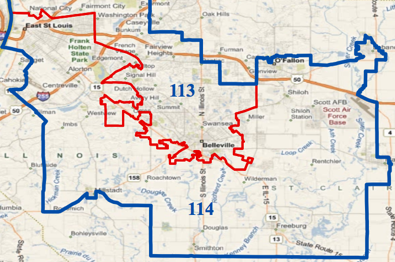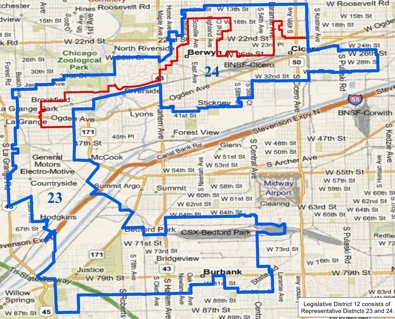
Latest Post | Last 10 Posts | Archives
Previous Post: Arbitrator rules against Quinn, says multi-year union contracts are imperiled
Next Post: Grid Modernization: A Catalyst to Get Illinois’ Economy Moving Again
Posted in:
* The Illinois House and Senate Republicans’ lawsuit against the state legislative remap can be read by clicking here. From their press release…
* The [Democratic] map violates the federal Voting Rights Act of 1965 because African Americans and Latinos have not been provided a “fair opportunity” to participate in the political process.
* The process by which the map was approved violates the Illinois Constitution because the map was not made available to the public or the legislature for a sufficient amount of time for review.
* The map violates the 1st Amendment to the United States Constitution because it dilutes the voting power of Republican voters throughout the state
* The map violates the compactness requirement of the Illinois Constitution and is less compact than the previous map and the Fair Map put forward as an alternative.
* Greg Hinz…
Other plaintiffs include African-American and Latino individuals, but no major groups from either of those communities. That could be significant, because the federal courts traditionally give huge weight to complaints from minority groups that feel they have been cheated of their opportunity to elect officials from their communities.
More…
The suit contends that two new House districts, the 7th and 114th, could easily have been given a more than 50% voting-age African-American population, but were not. As a result, it says, the map creates only 16 black-majority districts, not the 18 required by results of the 2010 Census.
Similarly, House districts 23 and 60 could have been made Latino majority, but were not, and six other districts could easily be more Hispanic, it says, calling that failure a “gross deprivation of . . . constitutional and statutory rights.”
The suit also contends that the map approved by lawmakers last spring is “an intentional, systematic and unfair political gerrymander” designed to “protect Democratic members of the General Assembly and to prevent re-election of a Republican majority.”
* Back to the suit…
Certain of the districts in the Redistricting Plan including, but not limited to, Representative District 96, are of a shape so bizarre on their face that the shape can only rationally be understood to be an effort to separate voters into different districts on the basis of race.
No sufficient or neutral justification exists for the bizarre shape of Representative District 96.
The 96th…

* More from the suit…
The Redistricting Plan pits 25 incumbent Republican members of the General Assembly against one another while pitting only eight incumbent Democrat members of the General Assembly against one another, without any neutral justification for this partisan
discrepancy.The Redistricting Plan’s pitting significantly more incumbent Republicans against one another than incumbent Democrats is a deliberate attempt to enhance Democrats’ prospects for reelection and targets Republicans to prevent their reelection. […]
…many of these bizarrely-shaped districts are clearly intended to slither across traditional lines in order to place multiple incumbent Republicans into one district. […]
The Redistricting Plan systematically and intentionally unfairly burdens Republican voters’ rights of political expression and expressive association because of their political views.
African-American voters comprise a sufficiently large and geographically compact group to constitute a majority of the voting-age population (”VAP”) in at least 18 Representative Districts.
The Redistricting Plan creates only 16 Representative Districts where a majority of the VAP is African-Americans.
Some specifics…
The African-American VAP in the area of Representative District 114 is sufficiently large and geographically compact such that Representative District 114 could have African-American VAP in excess of 50 percent.

Representative Districts including, but not limited to, 1, 2, 21, 22, 77 and 83 could be drawn to include Latino VAP sufficient to provide Latino voters a fair opportunity to elect representatives of their choice without violating constitutional requirements.
Some specifics…
The Latino VAP in Representative District 23 is 46.27 percent.
The Latino VAP in the area near and around Representative District 23 is sufficiently large and geographically compact such that Representative District 23 could have Latino VAP in excess of 50 percent.
23rd…

posted by Rich Miller
Wednesday, Jul 20, 11 @ 12:54 pm
Sorry, comments are closed at this time.
Previous Post: Arbitrator rules against Quinn, says multi-year union contracts are imperiled
Next Post: Grid Modernization: A Catalyst to Get Illinois’ Economy Moving Again
WordPress Mobile Edition available at alexking.org.
powered by WordPress.